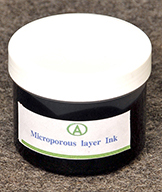Micro-porous Layer Ink
Fuel cell carbon ink is a specific type of ink utilized for producing the gas diffusion layer in fuel cells. The main purpose of its design is to include carbon particles, which are essential for creating a conductive and porous layer called the micro-porous layer (MPL) in fuel cells. When a substrate, like a gas diffusion layer, is coated with carbon ink, it results in the formation of a slender and permeable layer. The ink's carbon particles possess excellent electrical conductivity, which facilitates the movement of electrons generated in electrochemical reactions. In addition, the unique porosity structure of the micro-porous layer enables reactant gases to penetrate and interact with the catalyst in a more efficient manner.
The formation of the microporous layer necessitates the utilization of carbon ink, which is composed of carbon powder and either a PTFE or PVDF binder. To obtain a uniform ink, a high-speed mixer is employed to thoroughly blend the carbon with binder for uniform homogeneity. The stability of the ink is over six months. The ink's consistency varies between 400 and 1000 cps. You can purchase it in batches of 100 grams. This ink is applied in fuel cells operating at low and medium temperatures, and is also utilized for the electrodes of metal-air batteries.

